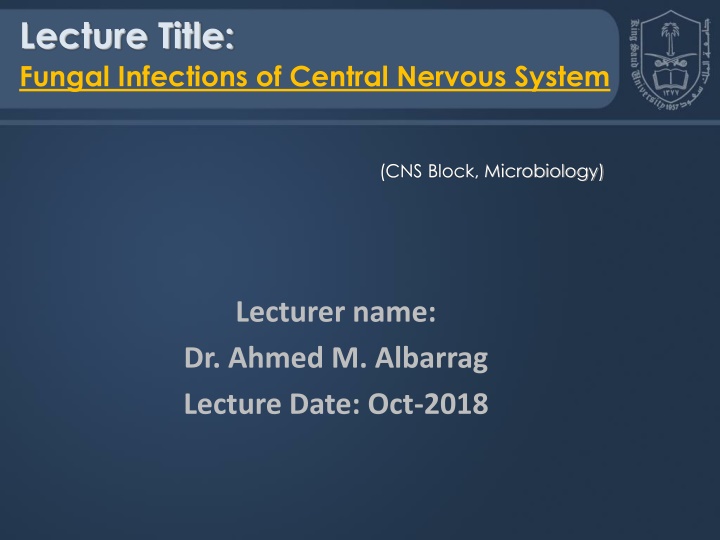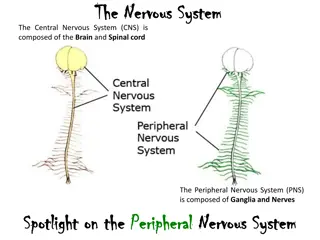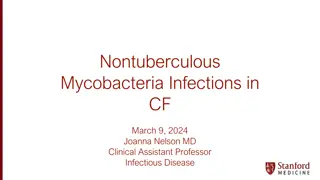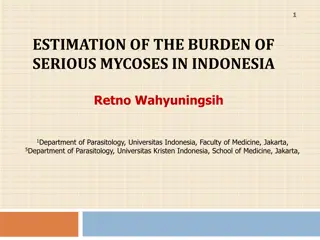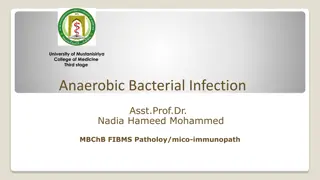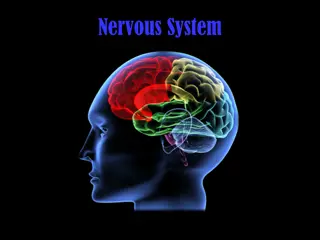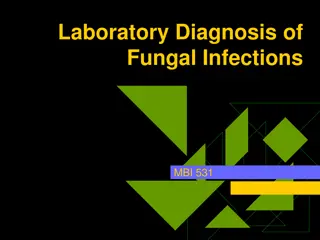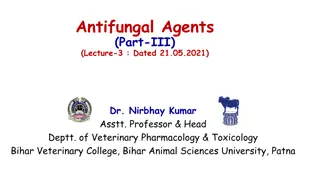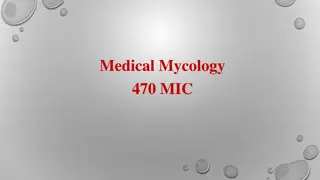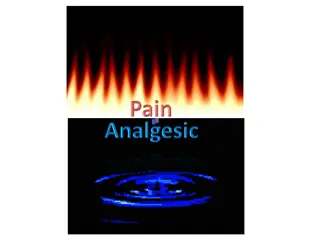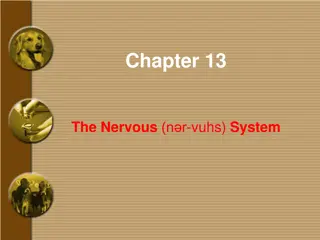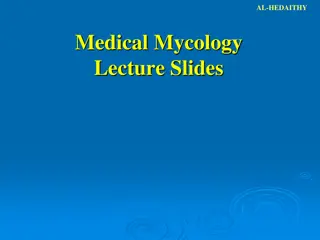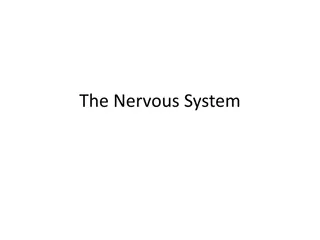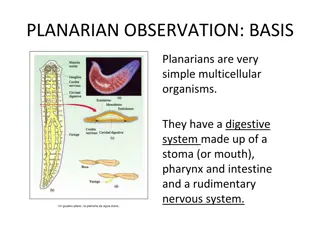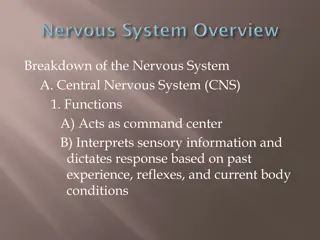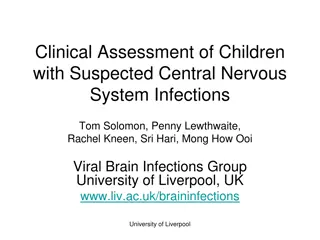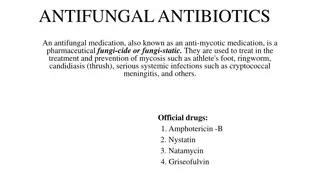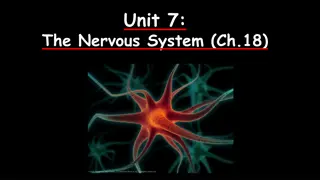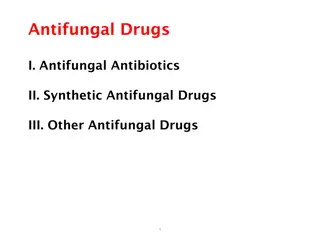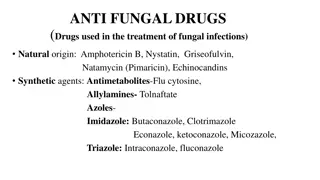Fungal Infections of Central Nervous System: Clinical Insights
Fungal infections of the CNS present diagnostic challenges and potential serious outcomes. Learn about main fungi causing infections, clinical manifestations, and mechanisms of CNS invasion. Explore the impact of predisposing factors like HIV/AIDS and transplantation.
Download Presentation

Please find below an Image/Link to download the presentation.
The content on the website is provided AS IS for your information and personal use only. It may not be sold, licensed, or shared on other websites without obtaining consent from the author.If you encounter any issues during the download, it is possible that the publisher has removed the file from their server.
You are allowed to download the files provided on this website for personal or commercial use, subject to the condition that they are used lawfully. All files are the property of their respective owners.
The content on the website is provided AS IS for your information and personal use only. It may not be sold, licensed, or shared on other websites without obtaining consent from the author.
E N D
Presentation Transcript
Lecture Title: Fungal Infections of Central Nervous System (CNS Block, Microbiology) Lecturer name: Dr. Ahmed M. Albarrag Lecture Date: Oct-2018
Lecture Objectives.. 1. To know the main fungi that affect the central nervous system and the clinical settings of such infections. 2. To acquire the basic knowledge about fungal meningitis and brain abscess: clinical features, etiology, diagnosis, and treatment.
CNS infections are both diagnostic challenge and medical emergency Delay in diagnosis and initiation of appropriate therapy will lead to high mortality rate or in permanent, severe neurological damage Fungal infections of the CNS are not common However, they are being increasingly diagnosed Why?
HIV/AIDS Hematopoietic stem cell transplant (HSCT) Solid organs transplantation Malignancies Neutropenia Hereditary immune defects Immunosuppressive medications Diabetes mellitus Surgery or trauma Indwelling catheters (e.g. candidemia CNS seeding)
Fungi reach the central nervous system by different mechanisms: Hematogenous spread Local extension from the paranasal sinuses, the ear, or the orbits. Traumatic introduction Surgical procedures Head trauma Injections lumbar punctures
Meningitis Sub acute Chronic Brain abscess With or without vascular invasion These clinical syndromes can occur either alone or in combination. Certain clinical syndromes are specific for certain fungi
Several fungal agents can cause CNS infections. Yeast: Candida spp Cryptococcus spp Mould Aspergillus spp Zygomycetes Fusarium spp Dimorphic Histoplasma spp Blastomyces spp Coccidioides spp Paracoccidioides spp Penicillium marneffei Exophiala spp Cladophialophora bantiana Curvularia, Bipolaris Rhinocladiella mackinziei and Others
Cryptococcal meningitis AIDS is the leading predisposing factor Etiology: Cryptococcus neoformans is the most common etiology Capsulated yeast cells Naturally in Pigeon habitats Acquired by inhalation Mainly meningitis
Candidiasis Candida species are the fourth most common cause of hospital acquired blood stream infections Candida can reach the CNS Hematogenously, Surgery, Catheters Indwelling catheter and fever unresponsive to antibacterial agents Clinical syndromes Cerebral microabscesses Cerebral abscesses Meningitis Vascular complications ( infarcts, hemorrhage) Etiology: Candida albicans, and other species including C. glabrata, C. tropicalis C. parapsilosis, and C. krusei.
CNS Aspergillosis Usually brain abscesses (single or multiple) A severe complication of hematological malignancies and cancer chemotherapy, transplantation Spread Hematogenously may also occur via direct spread from the anatomically adjacent sinuses, Angiotropism (infraction and hemorrhagic necrosis) Mortality rate is high Etiology: Aspergillus fumigatus, but alsoA. flavus, andA. terrus
The rhinocerebral form is the most frequent presenting clinical syndrome in CNS zygomycosis. Diabetics with ketoacidosis, in addition to other risk factors The clinical manifestations of the rhinocerebral form start as sinusitis, rapidly progress and involve the orbit, eye and optic nerve and extend to the brain Facial edema, pain, necrosis, loss of vision, black discharge Angiotropism; As angio-invasion is very frequent Etiology: Zygomycetes e.g. Rhizopus, Absidia, Mucor Fast growing fungi Mortality is high (80- 100%) Progression is rapid, To improve the outcome: Rapid diagnosis Control the underlying disease Early surgical debridement Appropriate antifungal therapy
Pheohyphomycosis Fungal infections caused by dematiaceous fungi Neurotropic fungi CNS infections: Usually brain abscess, and chronic Reported in immunocompetent hosts Etiology: Rhinocladiella mackenziei ( Mainly reported from Middle East) Cladophialophora, Exophiala , Curvularia, Fonsecaea ,
Other Infections Histoplasmosis Blastomycosis Coccidiodomycosis Paracoccidiodomycosis Caused by primary pathogens Sub acute or chronic Meningitis (common), and brain abscess Following a primary infection, mainly respiratory
Clinical features (history, risk factors, etc) Not Specific Neuro-imaging Good value in diagnosis and therapy monitoring Lab Investigations CSF examination (cell count, chemistry) Histopathology Microbiology
Clinical Samples CSF Biopsy Pus, aspirate Blood (for serology) 1. CSF abnormalities Cell count Glucose level (low) Protein level (high) Not specific for Fungal infections
2. Direct Microscopy Fungal stains: Giemsa, GMS, PAS, India ink (Cryptococcus neoformans) 3. Culture Fungal media: SDA, BHI, other media if needed. 4. Serology Candida Aspergillus Cryptococcus Histoplasma Blastomyces Coccidioides Paracoccidioides 5. PCR
CNS infection Direct microscopy Culture Serology* Cryptococcal meningitis Yeast cells Capsulated (india ink) Yeast Cryptococcal Ag (capsule) Latex agglutination Candidiasis Yeast cells and pseudohyphae Yeast Manann Ag (cell wall) Aspergillosis Septate branching hyphae Hyaline mould Galactomannan Ag Zygomycosis Broad non-septate hyphae Hyaline mould Fast growing No serology available Pheohyphomycosis Brown septate hyphae Dematiaceous mould No serology available *Serology: -D- Glucan For diagnosis of invasive fungal infections except cryptococcosis and zygomycosis
1. Control of the underlying disease 2. Reduce immunosuppresion, restore immunity if possible 3. Start antifungal therapy promptly Polyenes Azoles Echinocandins Consider surgery in certain situations
CNS fungal infection Treatment Cryptoccocal meningitis Amphotericin B (combination with Flucytosine) CNS Candidiasis Amphotericin B, Caspofungin, Fluconazole, Voriconazole, CNS Aspergillosis Voriconazole, Amphotericin B (Combination of Voriconazole and Caspofungin) CNS Zygomycosis Amphotericin B
Thank You (CNS Block, Microbiology) Dr. Ahmed M. Albarrag Oct-2018
